Now to a topic of regular discussion between expats: Learning Spanish. For us expats to get along here, knowing some conversational Spanish is essential as much as some of us might resist or ignore that fact.
But there is so much assistance available to help you overcome whatever resistance you may feel. In fact, you can choose from a huge pool of options that we share below. And you get to decide whether to dip your toe into the pool or dive in headfirst. And it’s your decision to dive in the shallow end or the deep end …or to swim leisurely or even freestyle it from one to the other. Of course, you might choose to just hang out and stay dry in a deckchair, chatting with other expats, but life will likely be less interesting and you will still probably struggle without some Spanish.
Cuenca, Ecuador is not like a Cancun beach resort where all the staff speaks some English. Most people in this city of 500,000 do not speak any English. It’s their world and we just live in it, as they say.
So, Spanish is how you tell the woman at the tienda what avocado you want or how to ask for a date, make local friends, tell a taxi driver your destination, or tell the doctor where it hurts. If you take a moment to identify and understand your own, personal learning motivation, it will help you get in the water and keep swimming.
Even we seniors are good candidates for language learning. Sure it’s a bit more challenging now than when we were kids. What isn’t? But there are lots of different people and new, enjoyable learning methods available at a very affordable cost to help us grasp the basics and go way beyond that too.
The other good news is that even if you didn’t take Spanish classes in school when your brain was spongy and you remembered stuff without trying, you can still get started and enjoy the process of learning the language and using it. And many classes in Cuenca specialize in senior learning because seniors are their core customers.
Buzzwords: Avoid going down the jargon rabbit hole. Words like “immersion”, “oral method”, “active conversation”, and “verb conjugation” can sound a bit technical. I think many of them just describe ways to help you keep practicing. And the instructors will tell you that practice is the key to competency. If you can push past a little fear and embarrassment of making mistakes, you can start conversing with whatever level of Spanish you have. Hint: nobody cares if you make mistakes except you. We all do it. Forever.
And if you try enough you will get better at it. And if you study with a professional or even just on your own with some good resources, you will get a lot better and gain confidence so you can practice some more with whoever is willing to chat with you. Then practice some more.
First, I cover to get learn some ways to get started before you come to Cuenca. Getting a headstart will make your first visit here much more meaningful and fun.
Then the core of this guide covers 8 well-respected instructors and will give you an idea about the potential “fit” between you and them and their various methods. Then, you can confidently jump in soon after you arrive or even if you have been here awhile.
Last, I share some extras including insights from a largely self-taught expat on what worked for him, a quick spin through one very effective traditional method (intercambios), and just a few of the newer learning tools.
Oh, and there is a cool surprise at the very end that will boost your Cuenca street cred fast.
OK, then. ¡Vamos!
Learn Some Spanish Before You Come to Cuenca

Jason Scott, our publisher, wrote “8 Best Ways to Learn Spanish Before Cuenca” to help prospective expats prepare for immersion in Cuenca’s language and culture. Here is a summary of tips in case you missed it.
- Enroll in a course, either online or in-person, to learn the basics of the language. Try websites such as Duolingo, Rosetta Stone, and Babbel.
- Practice speaking with native speakers, either in person or through language exchange programs such as iTalki or Tandem.
- Immerse yourself in media such as movies, TV shows, and music to improve listening comprehension and vocabulary. Watch shows such as “La Casa de Papel” and “Narcos” as well as music artists like Shakira and Daddy Yankee.
- Read books, newspapers, and magazines for reading comprehension and grammar. Start with children’s books and gradually progress to more challenging material.
- Participate in cultural activities that involve the language and culture, such as attending festivals or cultural events. Look for local cultural centers or Meetup groups to find these types of activities.
- Use language-learning apps such as Quizlet or Anki to create flashcards and practice vocabulary. Regular practice is the key to reinforcing skills.
- Take advantage of online resources such as YouTube videos and podcasts to improve listening and speaking skills. Search for resources specifically tailored to your level of expertise.
- Find a tutor or language school in Cuenca to continue language learning and practice while immersed in the local culture.
Before jumping on number 8, I suggest you research Cuenca language schools before traveling to Cuenca to find the best potential fit.
And we did preliminary research for you that appears in the following section covering 8 Cuenca Spanish Instructors.
Spanish Instructors
| Business | Instructor | Mobile/Whatsapp Number | Email Address | Website URL | Facebook Page Link |
|---|---|---|---|---|---|
| Ana Luisa Spanish Classes | Ana Luisa Alvarracin | +593998358680 | [email protected] | Ana Luisa Spanish Classes | Ana Luisa Spanish Classes |
| CCC Idiomart | Fausto Balarezo | N/A | [email protected] | None | CCC Spanish Idiomart |
| Spanish Institute | Eva Franco | +593961800620 | [email protected] | SPANISH INSTITUTE | Spanish Institute |
| Pensar en Español | Patricia Olivo | +593968449614 +593995907240 | [email protected] | Learn Spanish Cuenca | Learn Spanish Cuenca |
| ¡Vamos! Spanish School | Carmen Pais | +593982999083 | [email protected] | vamospanishschool | Vamos Spanish School |
| Spanish to Fluency | Nadine Panta Flexhaug | +593983194028 | [email protected] | Spanish To Fluency | Spanish To Fluency |
| Interactive Spanish Classes | Estefanía Reyes | +593994124589 | [email protected] | N/A | N/A |
| Felipe Vintimilla Spanish | Felipe Vintimilla | +593959258782 | [email protected] | N/A | Flora Caffe’ |
Spanish Instructor Overviews
Below we feature summaries of 8 different instructors. There are certainly more than 8 good ones but we are confident in presenting the list below because they all came recommended by other expats and they will all share reference contact information. Here we go…
Ana Luisa Spanish Classes, Ana Luisa Alvarracin Cabrera

Ana Luisa specializes in making classes comfortable, affordable, and fun. She offers group and individual Spanish classes in a classroom on Tres de Noviembre, a one-minute walk from Cafe Museo, or through video conference and offers a six-week program based on the Oral Method of teaching, with classes shaped around comprehension, interest, involvement, and meaningful repetition.
The Oral Method develops conversation skills using stories to put fun into learning. She also emphasizes reading to acquire vocabulary, phrases, and grammar as well as listening to everyday conversation. Each class has practical elements that help grow your understanding of Ecuadorian culture through instruction in cultural context, current events, and everyday situations.
Classes consist of card and word games, storytelling exercises, and articles to improve reading, sentence structures, and comprehension. They also involve students in cultural activities and trips to different communities. She studied tourism at University so is well-equipped to integrate cultural lectures, guided visits, and student trips to different communities into her program.
Ana Luisa specializes in adult learners that incorporate particularly useful methods for adults such as transactional conversation, an innovative story-based method that puts the fun back into learning. She has been teaching since 2007 and caters to a diverse group of students from different age ranges, with students mainly from the United States and Canada. She has a passion for traveling and shares her experience to help others understand the richness of the Spanish language and culture. She offers multiple levels to accommodate everyone, from Beginner to Advanced, with sublevels in each of them.
At the end of the year, she offers 1 or 2-week-long conversation courses focused on vocabulary, idioms, and conversation exercises done in pairs and groups. The objective is to help gain fluency and improve confidence in your conversation skills with heightened exposure to points of view and the use of connectors when speaking. Topics are related to daily activities, cultural issues, and current events in Ecuador.
Students can register now for classes running from May 1 to June 9th.
The cost for regular courses is $100 for 18 hours of instruction over 6 weeks, $5-$35 for cultural lectures and trips, $65 for conversation classes, and $100 for a package of 10 one-hour sessions for online tutoring.
Thanks, Ana, for recommending some killer online study aids:
- El hilo: Home
- https://radiolingua.com/category/coffee-break-spanish/
- https://www.notesinspanish.com/
- https://radioambulante.org/
- https://www.newsinslowspanish.com/?switch
- https://quizlet.com/
idiomART CCC Spanish and Cultural Exchange – Fausto Balarezo and Martha Pulla

Spanish Instruction
Fausto Balarezo and his program co-director and wife Martha Pulla, have run the language program for 18 months at Idiomart Creative Center and Art Gallery at Mariscal Lamar 14-25 & Estevez de Toral. They are all about building your confidence through active conversation, helping you feel more comfortable communicating and ready to build on your skills. Listen to this interview with Fausto to get a feel for his approach – whilst it’s in Spanish, you may be surprised how much you understand thanks to Fausto’s clear pronunciation.
The pair follow the core belief in the words behind the acronym CCC – conversation, culture, and context- having found that emphasizing the 3 elements results in the greatest success for students.
With their dedication to promoting language and cultural immersion over the past year, they have made significant contributions to the program and to the Cuenca expat community generally. For example, each month, they arrange a cultural excursion outside of the city’s limits, taking groups to lesser-known areas that showcase various community and family tourism projects with a particular emphasis on language and culture.
Their take on grammar is a little different and largely painless. They have decades of experience in gently integrating grammar points with their conversation and listening methods. Fausto and Martha authored a Spanish language grammar and exercise book with their colleagues while teaching at the same language institute years ago. Their book, along with their method, has helped many improve their skills.
Classes are structured for (small) groups, individuals, and pairs according to your needs. In addition to organizing a monthly city tour, they facilitate a conversation club in a restaurant setting where you can practice your skills with others.
They have also organized a cultural immersion program (below) that gets you direct involvement in Ecuadorian culture using optional volunteer community placements. Classroom instruction is combined with monthly cultural road trips outside the city limits community and family tourism projects focused on language and culture.
Pricing is available by contacting idiomArt and charges are monthly. For a two-month or greater commitment, you receive a 10% discount.
idiomART is a YapaTree Partner, offering 5% off any artwork (gallery or exhibition). Instagram idiomart.cuenca
Cultural Exchange
The CCC Spanish Cultural Immersion Program immerses you in Cuenca’s rich culture and introduces you to new people as a path to learning Spanish. You will stay with a local family, which is the bedrock of Ecuadorian culture. Additionally, you go on weekend excursions outside the city each week so you can explore the country and practice in real-life situations. The program lasts for four weeks and includes intensive Spanish classes and volunteer opportunities that have been carefully selected and vetted by the CCC Spanish program directors, Fausto and Martha.
You will spend your mornings learning Spanish and your afternoons volunteering, or vice versa, depending on your chosen volunteer opportunity where you put your Spanish into practice as you engage with the local community and give something back.
Four diverse volunteer options include working as a preschool English teacher, serving at an animal shelter, assisting at idiomART Centro Creativo, and working for Vistalsur Digital Magazine.
In summary, in addition to 40 hours of instruction, volunteers experience a homestay with a local family, two meals per day, and weekend excursions outside the city. The volunteer experience lasts four weeks and offers a true immersion in Ecuadorian culture. It is worth noting that the program participants can opt out of volunteering or homestay with a local family if desired.
The Spanish Institute, Eva Franco
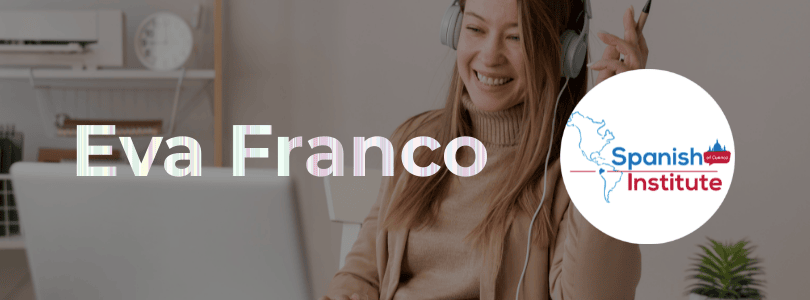
The Spanish Institute, located at 11-60 Sucre St., is run by Eva Franco who places a great deal of emphasis on training her teaching staff and on their preparation before each class to address the needs of individual students. She has personally taught for 5 years of the 11 years the institute has existed. It offers Spanish lessons to both individuals and groups. Individual classes can be held in a classroom or in the student’s homes, or via video conference. The group lessons are offered several times throughout the year, while the individual lessons are available year-round. The price for classes is $10 per hour.
Eva’s teaching focuses on practicing Spanish and using grammar as a complement. She treats grammar as important but not the most important thing. The focus of activities and reading material is creating opportunities to converse in the context of learning local culture. Materials are tailored to each student’s learning style, goals, and skills, making each class unique and enjoyable. Classes also include outdoor activities with locals to learn about the culture and customs of the area. She also provides a friendly, comfortable environment.
Eva offers walking lessons where students learn while exploring the city. Students also play board games, read comic books, and engage in outdoor activities in a fun and interactive way. She provides local food, tablets, Ecuadorian books, and other materials to create a full immersion experience for the students.
Teachers are enrolled in training every month on topics like culture, methodologies, and technology. 90% have university degrees and 50% have master’s degrees all from highly respected universities. And they are tasked with preparing classes based on students’ needs, goals, and skills.
Students range in age from 3-year-olds to 85-year-olds. The majority of the students are from the US and Canada, and classes are divided by age groups: 25 to 40 and 55 to 75 most of whom are beginners and intermediates. The students come from all education levels, most with either university degrees or postgraduate degrees.
There are audio and video materials for students to practice listening and comprehension skills, including podcasts at different speeds plus language exchange opportunities and flashcards to help students practice everyday conversation. In addition, students advance their knowledge by engaging all of their senses, not just sight and hearing but taste, smell, and touch.
The Spanish Institute has become an international destination because it is fun, highly personalized, interactive, and focused on practical language skills.
Eva recommends a gradual approach to accessing learning through media and other means:
- Movies and series: First step, audio in English and subtitles in Spanish. The next step is audio in Spanish with subtitles in Spanish. And finally audio in Spanish without subtitles.
- Linguee: As a dictionary for intermediate and advanced students.
- Podcasts in Spanish: 0,5 speed and increase when you understand.
- Language exchange: All the time.
- Flashcards: Label your house or condo with vocabulary.
Pensar en Español, Patricia Olivo
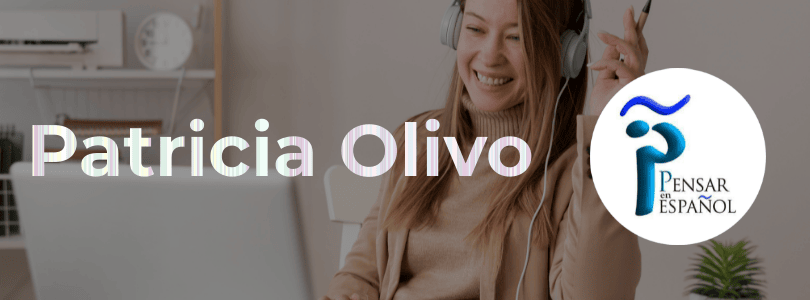
Patricia Olivo has taught expats for 10 years and a total of 25 years in teaching. Per Patricia, her learning experience is differentiated by her warm sense of humor and “the materials, graphics, and games that I use because they focus on the social and political reality of Latin America and Ecuador”
She offers group classes at Estevez de Toral 13-31 y Estevez de Toral (first floor) with four or more students and individual classes with three or fewer students. Classes are segmented according to learning objectives and knowledge levels. Instruction occurs in the classroom and via video conferencing, but not in students’ homes. She likes teaching in a group because the interaction between students as well as with her adds value and she keeps things well-directed in the middle of it all. On the other hand, she prefers not to teach at students’ homes because frequent distractions interrupt learning.
Each course lasts a month with 18 hours of classes 3 consecutive days from Monday to Wednesday. And each is an hour and a half with different levels of courses such as basics, upper intermediate, advanced, as well as introductory Spanish. The cost for each course is $100, including materials. Private tutoring courses cost $8 per hour.
To facilitate understanding, she creates graphic diagrams of the topics. Students appreciate the way she outlines concepts and the materials she uses as well as her sense of humor which she says is very important to disarming nerves.
Patricia believes that there is no perfect method for all people and that an eclectic approach is a way to go. She employs various, empirically proven teaching methodologies depending on the topic and student profile. These have names like the inductive method, cognitive method, and comprehensible input method. To keep things fun and interesting, she uses a lot of graphics like Quino’s comics and print material with traditional stories and board game cards. In small or private groups via Zoom, she uses videos and songs.
Depending on the level of the student, Patricia advises them to use memory cards, listen to music, watch movies with subtitles, sing, and do karaoke for pronunciation. She recommends reading at different levels to improve vocabulary and reading comprehension at times suggesting children’s stories or complete novels. The materials shed light on local customs, culture, and traditions which makes learning more interesting and valuable.
80% of her students are American or Canadian over 60 years old, and mostly men. The remaining 20%, are very young Europeans between the ages of 18 and 25 with prior Spanish education who come to Ecuador as volunteers for various organizations. In her advanced-level courses, there are more women who have some command of the language wishing to perfect it. Patricia has a degree in Spanish language and literature with a postgraduate degree in Spanish as a Second Language.
Patricia, or “Pachi” to her friends, has worked for various European and American organizations such as North American Baptist Missions, Equinoccial Spanish School based in Quito, Caritas volunteers from Austria, and Bezev from Germany. She is currently a mentor to the volunteers who arrive in Cuenca and a professor of the Social Ministry of Cuenca. Pachi was also my Cuenca Spanish instructor and she taught me a lot of Spanish despite my prior high school spanish education and a steadfast refusal to do my homework! (Worst adult student EVER.)
¡Vamos! Spanish School, Carmen Pais
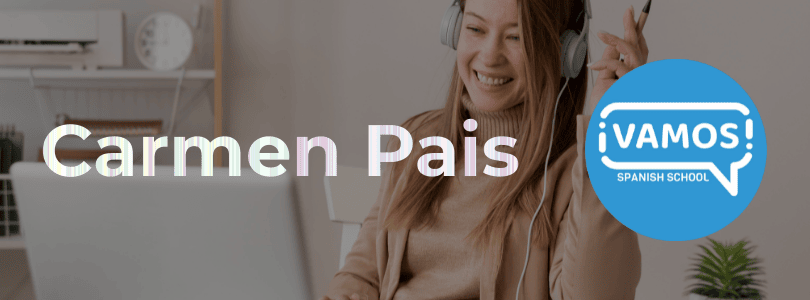
Carmen says that two things differentiate her school: 1) That it follows the specifications from the Common European Framework of Reference for Language Skills. 2) All instructors are true Spanish teaching experts with backgrounds in teaching Spanish as a second language degrees in language teaching and Spanish as their native language.
Carmen and her team of instructors approach teaching with engaging materials aimed at making learning enjoyable. They also create a safe environment to soften the fear of making mistakes while practicing speaking and listening. Audios, videos, songs, news from newspapers, and extracts from literary books to practice listening skills, with the cultural activities serving as an opportunity to integrate what has been learned in the class.
Carmen herself has been teaching Spanish as a foreign language for over 15 years and is the founder of ¡Vamos! Spanish School, located in Calle Larga 11-43, in front of Mercado 10 de Agosto. She and the school provide regular and intensive Spanish language courses for all levels of prior knowledge and a wide variety of workshops that immerse students in Ecuadorian culture.
There are three types of group classes: intensive, semi-intensive, and regular. Intensive courses last for one, two, or three weeks, and include guided trips into the city. Semi-intensive courses also last for one, two, or three weeks, and involve two hours of class every day from Monday to Friday and include guided trips into the city. Regular courses last for six weeks two days per week, two hours per day. All levels include access to cultural workshops at no additional cost.
The maximum number of students per class is five, which allows the instructor to cater to the individual needs of each student. In addition to classes with 5, Carmen also offers them for three or fewer students in a classroom or at the student’s homes and by video conference.
Extracurricular activities include a Language Exchange on Saturday mornings, a Spanish book club that meets once per month, and frequent cultural activities, such as Ecuadorian cooking classes, fruit-tasting events, Latin-American movies, and guided visits to the city and museums.
All instructors at the school have a background in teaching Spanish as a second language, degrees in language teaching and Spanish as their native language. Class contents are personalized according to the individual needs of each student. Included is a workbook made with selected materials that have proven to help students in their learning process.
The cost of private classes is $10 per hour, while the cost of regular group classes (24 hours of class) is $150, an intensive course (20 hours) is $120, and a semi-intensive course (30 hours) is $185. Students are encouraged to practice every day with small amounts of repetition and daily practice is more beneficial than practicing for long periods less frequently. Learning aids including language exchanges, Duolingo and Spanishdict have proven helpful.
Most of the students are over 50 years old, although the school offers specific courses for younger people as well. Students are evenly divided by gender and come from various countries, such as the United States, New Zealand, China, South Africa, Canada, the United Kingdom, Germany, and Ireland, and have different levels of knowledge and prior education.
Classes are starting again in late April and early May. Open spots are available for beginners, intermediates, and advanced students: [email protected]
Spanish to Fluency, Nadine De Panta Flexhaug
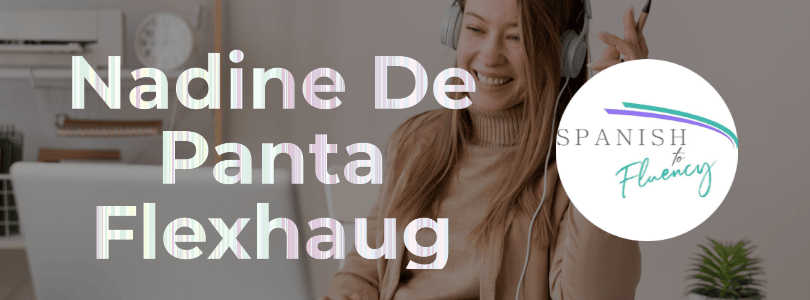
Spanish to Fluency is different from the other programs as it is language coaching conducted only via videoconferencing that offers conversational lessons as the core of the program. This unique approach uses conversation practice sessions with certified native speakers, lessons, and personalized Neurolanguage coaching. Another component is access to training videos that teach the neuroscience of adult language learning.
Nadine lives and works in Canoa Ecuador, holds a TEFL certificate, and has studied at the Universidad Particular de Loja, Ecuador. Her experience teaching English, combined with her training in Neurolanguage coaching and her own experience learning Spanish as an adult led her to develop a program that focuses on better conversational skills. Her website is exceptional and shares clear explanations of her neuroscience approach and a helpful blog with tricks and tips.
Coaching works with the brain’s natural learning processes to train the brain to think in Spanish. This leads to an instinctive understanding and practical application of the language, reducing the need for you to translate in your head. The program focuses on fluency techniques such as self-talk, imitation, shadowing, and 2-minute monologues to train the brain to think in Spanish and piece sentences together creatively.
One big difference in the program is lots more conversation practice time for students. Students converse for an hour with native speakers, 3-4 times a week, so they develop an instinctive understanding through practical application. The use of proven fluency techniques allows students to increase the fluidity of their speech and conjugate verbs on the fly.
The mirror method, which is similar to how people learn their native languages, is also used during conversations and helps the student naturally adopt new language patterns with consistent practice.
The combination of practice with native speakers as well as coaching and instruction by a bilingual coach means that English speakers can understand and grasp the language quickly.
The coaching program offers 6-week and 12-week programs, and progress is visible and tangible by the end of each. It is results-oriented, and instructors and students are motivated to achieve specific goals that create a holistic path to learning.
Videos, short stories & articles, fluency techniques, music, and other resources are all used to provide an “almost real-life” setting with lots of contexts that allow the student to internalize information on a subconscious level, where the long-term memory is stored. The coaching aspect emphasizes the need for students to find methods that resonate with their learning style and align with their goals.
Nadine has a diverse customer base of adults, with about 60% of them being retired expats, and the rest are working or planning to move to Latin America/Ecuador. Most of the students are from the US or Canada. The program is suitable for both beginners and individuals who have been studying the language for years.
Free Workshop: Nadine is hosting a free 2-day online workshop Tuesday, April 18th, and Wednesday, April 19th at 5:30 pm Eastern Standard Time. Training Your Brain to Think in Spanish. You can get more details and register for it here.
Interactive Spanish Class, Estefanía Reyes

Estefanía Reyes is all about small, one-on-one, interactive Spanish classes for individuals or small groups of up to three students. She holds them in a classroom, the student’s home, or other locations such as parks, cafes, and museums. The classroom is at Campus Paraíso at Av 12 de Abril y el Paraíso next to Hospital Vicente Corral Moscoso.
The focus is on teaching grammar in a simple way and allowing students to practice their Spanish through conversations and visits to local places of interest. Estefanía also uses songs, stories, and readings to introduce new vocabulary and grammar rules.
She has experience teaching Spanish to students of different ages and nationalities, including children, young adults, and seniors from the USA, Canada, Russia, China, and Germany.
Estefanía has a degree in Tourism Engineering from the University of Azuay and studied Pedagogy in National and Foreign Languages at the University of Cuenca. She has also worked as an English and Spanish teacher at CEDEI School and as a tour guide in the Galápagos. Estefanía enjoys teaching Spanish and learning about her students’ cultures and life stories.
The cost of the classes is $8 per hour, and the location can vary depending on the student’s preference.
Felipe Vintimilla Spanish, Felipe Vintimilla

Felipe wins the award on our list for the longest time teaching Spanish: 34 years teaching it in Ecuador, Switzerland, Belgium, and the Netherlands. And for the last 9 years, he has been teaching it to expats in Cuenca. Felipe offers both tutorial lessons and group courses with up to 6 students with focuses on grammar, communication, culture, and visits to the city.
Classes are held in a quiet room inside ‘Flora Caffe’ located in ‘Plaza dell Otorongo’ on Benigno Palacios 15-23 & Avenida 3 de Noviembre. The prices of the Spanish courses are $6 for group classes with a duration of 90 minutes and $10 for the tours with a duration of 120 minutes.
As he explains it, his goal is to encouraged, develop and cement Spanish in his students. In so doing, he combines economics and history with his teaching experience in a passionate and flexible class. Felipe believes that Cuenca, with its varied culture, markets, craft workshops, and very friendly people, is the best setting to learn, practice, and develop Spanish skills.
Felipe offers courses according to a student’s interests and time availability, both in tutorials and groups. They enjoy a great atmosphere and quality instruction at an affordable price. Courses are structured for beginners, intermediate, and advanced learners. Courses are tailored to one’s experience with work, their study preferences, and hobbies.
There you will find different age groups, nationalities, education levels, and previous education in Spanish. Most are from the USA, followed by Europe, Canada, the UK, France, and China with the majority being females between 50 and 60 years old.
Felipe emphasizes the importance of grammar but balances it with cultural aspects to make it less burdensome. And he finds students find happiness in his class when they quickly learn the different past tenses. Felipe gives distinctive homework to his students, including writing, creating dialogues and stories about subjects that interest them, watching the news, and listening to the radio. He places special emphasis on practicing in the markets, workshops, taxis, and with friends while enjoying intellectual, sports, and musical activities.
Students benefit from his extensive life experience and appreciate the value of his advice about living in Cuenca, making friends here, and traveling around Ecuador. And he loves sharing his knowledge of Cuenca’s history and traditions as well as its foods through shopping in the mercados and art through visiting the Eduardo Vega Gallery, for example.
Felipe has held classes at Flora Caffe and A Pedir de Boca as well as in schools and universities in the Netherlands, Belgium, and Switzerland. He has also conducted summer courses at Lewis and Clark College and the University of Washington, Abraham Lincoln School, and Nexus School.
He has a degree in Economics from the University of Cuenca, where he also studied History and Spanish. He speaks Spanish, Dutch, Italian, French, English, and to a lesser degree German, Swedish, and Portuguese.
Some Useful Extras Before We Wrap Up

There is such enthusiasm in the expat community for learning the local idiom that we wanted to share some of the comments and suggestions we received from expats students here. First, we hear from Jeff Schinsky about his successful learning experience and Spanish learning group, then we will cover a few expat suggestions for tools and aids that are already at your fingertips. Then, we share some secret language that will make you sound like a true Cuencano!
Comments from One of Cuenca’s Serious Students of Spanish
A friend and Yapatree contributor, Jeff Schinsky, put some of his thoughts together on learning Spanish. He took on the challenge in some purposeful and creative ways. For starters, he knew very little Spanish when he moved here almost 10 years ago but immersed himself as he shares below. For one, he studied with Patrcia Olivo of Pensar en Español, one of the instructors in this article, and by marrying an Ecuadorian with 3 daughters!
Like my Ecuadorian partner and I, Jeff and his partner and daughters speak Spanish at home. So, we both get plenty of practice.
However, Jeff has taken his involvement to another level, helping other expats with their Spanish by creating and administering a Facebook Group, that everybody is welcome to join: Español para Extranjeros (Ecuador)
And he speaks with some academic authority about the best ways for adults to learn because one of his degrees is a BS in Occupational Education and he developed loads of computer-based training and education programs in corporate America. As an expat rather than a Spanish Instructor, I find his comments pretty enlightening and you may as well. OK, Jeff, you’re ON.
“I took several Spanish classes over my high school and college years, but I didn’t really remember much. For now, I am largely self-taught. I started off learning by listening to Spanish-language songs, then looking up the lyrics and doing my best to translate them. Then I’d sing along with them in the shower or in the car. The great part of this method is that each song is a story. Every story has context. Context greatly improves retention and recall, so it’s very unlikely that you’ll forget the words and phrases used in that song. Plus, it’s music! And there are all types and genres of music, so it’s not all mariachi music or reggaeton. Very important: Only use online lyrics that include the various accent marks and tildes, because the presence or absence of those can affect the entire meaning of a given word or phrase.
Another way to use music for improving your audio comprehension of Spanish is to put on some headphones, listen to a given song, and try to transcribe as many of the words as possible. You may have to listen to the same song many times to get most of the words, but doing this is an invaluable exercise, especially if you have trouble understanding spoken Spanish. One thing that makes this exercise easier is to find a way to slow down the song so you can better differentiate between the words.Once you’ve transcribed as many words as you can, go ahead and look up the lyrics online.
Then, somewhere into the process of learning Spanish, I stopped using Google Translate English to Spanish and started writing in Spanish in the left pane, and continued looking up the necessary words and phrases until the English translation in the right pane rendered what I was trying to say. I did this in the form of “journal entries” that I would share with native speakers in my Spanish-learning Facebook group (above). This was probably the most valuable thing I did in my journey to learn Spanish.
It’s very important to practice your Spanish with as many people as you can. If you only ever speak Spanish with your teacher or one or two friends, you’ll never get to a point where your audio comprehension is where it needs to be. Everyone speaks their own language a little differently, so you need to speak (and listen to) a wide range of different native speakers in order to become conversational and take care of business. Every new accent or speech pattern you listen to and are able to comprehend will have an exponential impact on your overall Spanish ability.
Important: Don’t be afraid to speak “bad Spanish” to native speakers. For one thing, native-Spanish speakers make grammatical and spelling errors just like we make in English. You can have a headful of Spanish knowledge, but if you’re not out there using it with real people in the streets, you’ll never get to the point where you’ll become conversational.
There are a number of learning tools and resources that I list and describe in detail in my group ( a learning resource where you can go to keep up on the latest learning tools, get native-speaker advice, and ask random questions).
One other HUGE factor for adults when learning anything is motivation. Unless adult learners feel motivated, they simply won’t bother learning whatever it is. Things I’ve used in the past are talking about “How are you going to tell someone that your heart pills are in your backpack when you collapse on the sidewalk?” Or if you’re otherwise sick, how are you going to tell someone where it works if you don’t speak a little Spanish? Same for asking directions, looking for items in Supermaxi, paying unexpected bills, dealing with bank issues, etc.”
Muchisimas Gracias, Sr. Jeff.
Language Exchanges aka Intercambios

Fluent Spanish speaker and YapaTree contributor, Joseph Kennedy reviewed some of Cuenca’s Language Exchanges in Intercambios in Cuenca: Make Friends and Practice Spanish. These groups give English and Spanish speakers a chance to practice with each other regularly. Every instructor in this article agrees that Language Exchanges give you practice that is hard to find elsewhere. Take a spin through Joseph’s article, watch his video, and try a few of the groups.
Spanish Learning Websites and Tools
Googling “Learn Spanish” produces a dizzying number of online training courses and far too many to mention. Expats in Cuenca recommended some websites consistently. Here are some quick overviews of three of them.
- Baselang: An online Spanish learning platform that provides unlimited one-on-one Spanish tutoring with native Spanish-speaking teachers for a monthly subscription fee of $150. Baselang offers flexibility, a customized curriculum, and affordable pricing. However, it lacks structure, may lead to dependency on tutors, and has limited interaction with other learners.
- Duolingo: A popular language-learning website and phone app that offers a gamified approach to learning Spanish. Duolingo’s pros include accessibility, bite-sized lessons, personalized learning, and a gamified approach. Its cons include limited conversational practice, lack of structure, and limited cultural context. Duolingo offers a free version and a premium version called Super Duolingo which costs $12.99/per month.
- LanguageTransfer: A free online resource that offers a unique method of learning Spanish through audio recordings and exercises. The pros of LanguageTransfer include its free cost, unique teaching method, comprehensive curriculum, and self-paced learning. However, it has limited interaction with teachers, lacks structure, and has limited multimedia content.
How to Sound Like A Real Cuencano
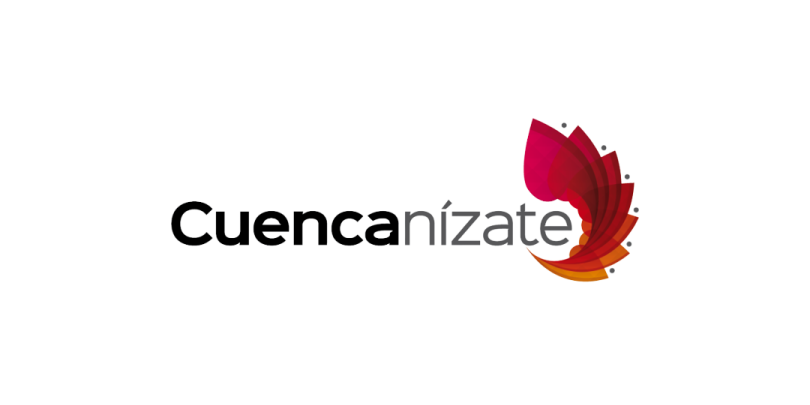
Yes, with just a little study, you too can confound your Ecuadorian neighbors, make cool, Cuencano friends and have more fun at cocktail parties. Check out the Diccionario de la Real Lengua Morlaca. Morlaca is a term referring to Cuencanos. The Lengua Morlaca or Language of Cuenca consists of words and definitions that evolved over many years and it mixes indigenous Quicha, Spanish, and phonetic equivalents for both. It also tends to attach completely different meanings to commonly used words. This is real idiomatic language. It’s like the way Zootsuitors in 1940 in Los Angeles used a special vocabulary to identify. “Yeah, Daddy-O. Groovy, man.” Or more recently the impenetrable slang of Gen Z. “Boujee Cheugy” – an overly trendy Millenial.
Published with some hard-earned, Cuencano tax dollars this Cuenca Municipality Publication features words like:
“Camaron” (not a tasty shrimp). It’s somebody who drives poorly. See also taxistas.
“Camote” (again, not the food). It’s a person who is enamored with somebody else.
“Chévere” I hear this one frequently. It means “cool” like groovy.
“Hueso” literally – bone. Somebody who misses an opportunity. Like a “bonehead” in the U.S. who showed up late for a job interview.
“ñato / ñata” is one who has a small nose. Hilarious.
Wrap-Up
By now I hope you are energized and excited about moving forward with mastering your preferred level of Spanish. And it may help to remember that “fluency” is a continuum not a fixed destination. If you learn enough to converse and read well enough to enjoy being part of the Cuenca community, you have reached your current level of fluency!
Recapping….
First, I covered some ways to get started before you come to Cuenca. Taking some action before you come means you will get off on a good foot (or at least a better foot) when you get here.
You got write-ups about 8 well-respected instructors and how they facilitate learning so you can start narrowing down your list before you get here. Or even if you have been here awhile thinking about launching (or extending) your Spanish language journey. Many of these instructors are also great for experienced Spanish speakers who want to polish their skills and are especially skilled at working with seniors.
Then in the “Extras” section, we heard from my friend, Jeff, who used his background in Adult Education to zero in tons of good ways to boost his Spanish that went way beyond traditional classroom study and homework. We also pointed you to a popular way to learn and meet new friends in several languages, the Language Exchanges. Finally, we finished with a light dusting of some new learning tools as well as a Cuencano Dictionary that will make you the fascinating gringo hit of wild Cuencano parties.
Please leave any comments that come to mind below as we like the feedback.
Buena suerte compañeros expatriados!















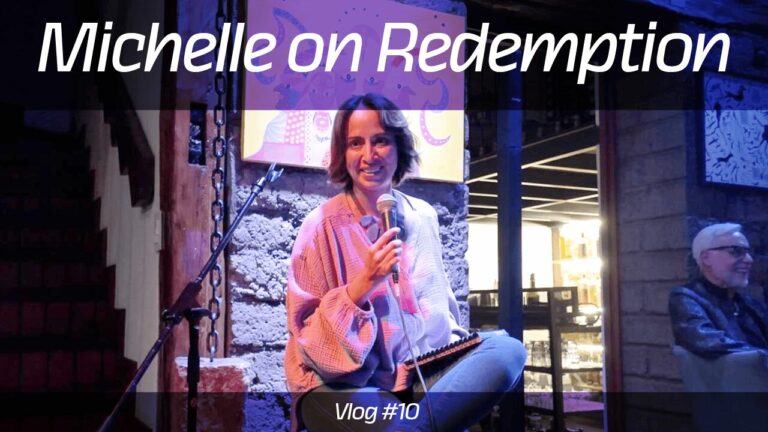



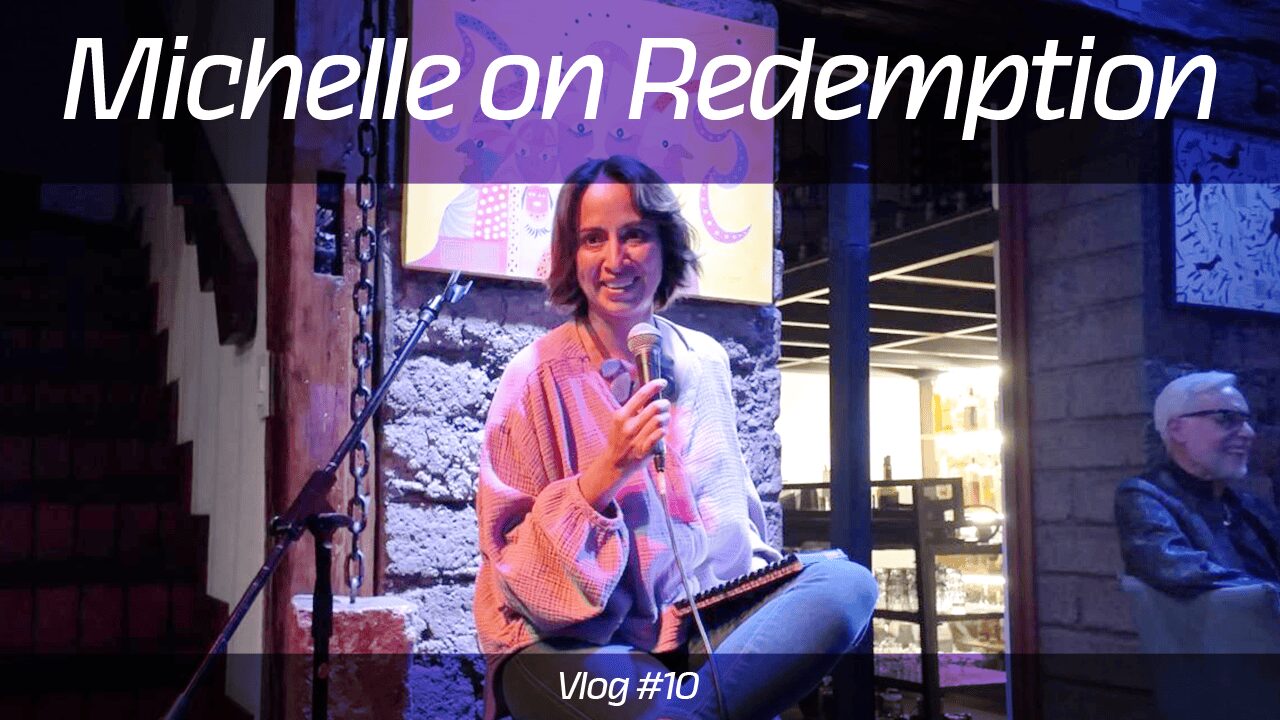
One Response
I have used this course, it is free, it is 90 lessons, it is very strong on grammar such as conjugations and much more, each lesson about 10 minutes more or less, well advised to listen and pause or even repeat a tough concept. It has an app but I ran the course on Soundcloud. There is also a course for your Spanish friends to learn English (plus several other languages. I am by no means fluent, that takes practice, but I know present, imperfect, preterite, conditional, future, subjunctive, present, and perfect, and much more, from this course. I did Duolingo and that was a waste of time to be honest. I have a lot to learn of course, this for me is not a race but a journey. http://www.languagetransfer.org